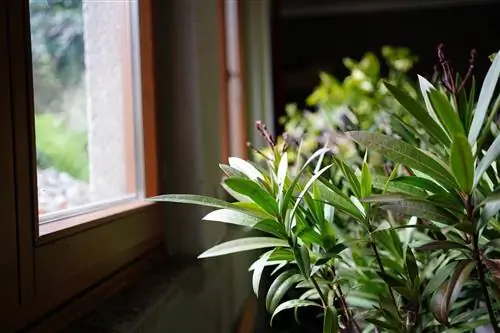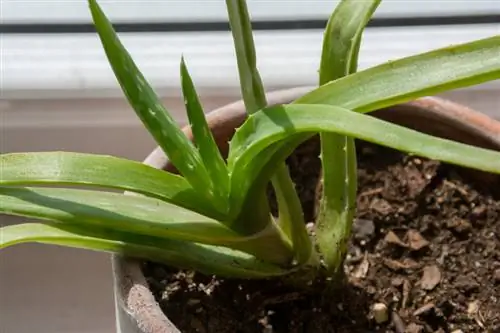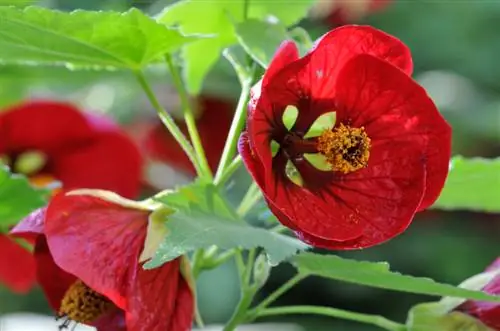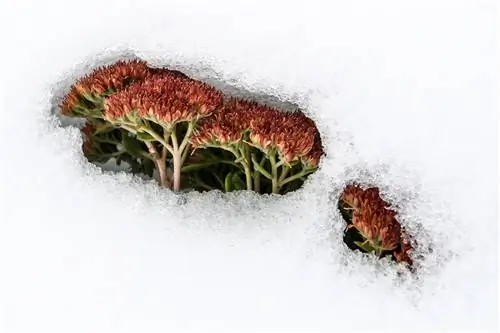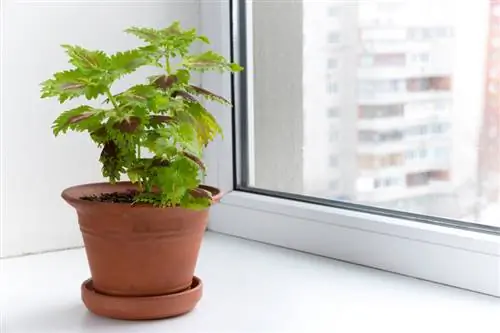- Author admin [email protected].
- Public 2024-01-31 08:49.
- Last modified 2025-06-01 06:02.
Oleander is only hardy down to -5 degrees. That's why planting in containers has proven successful in our latitudes. Depending on the location of the buckets, different protection and care measures are required.
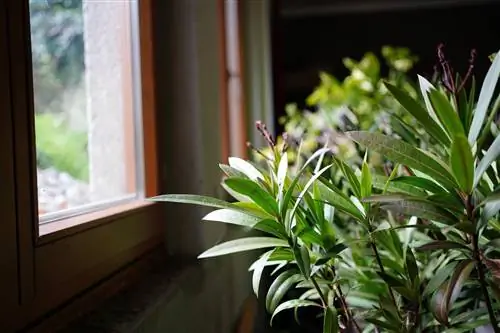
How is oleander overwintered?
Oleander is overwintered brightly and frost-free at 0 to 10 degrees from the first long night frosts in October or November. This can be done in the hallway, winter garden or greenhouse. Overwintering outdoors is possible if the bucket is protected. To do this you need a coaster made of e.g. wood, an earth protector made of e.g. leaves, a jute bag to protect the bucket and a fleece to protect the crown.
Is oleander hardy?
The oleander, which originally comes from the Mediterranean region, is only partially hardy in our latitudes. Almost all species can tolerate temperatures down to -5 degrees Celsius. However, it is important that additional protective measures must be taken for the root ball.
A few genera are even hardy down to -15 degrees Celsius. These include
- hardy red
- Italy
- Jannoch
- Margarite
- Nerium atlas
- Nerium villa romaine
- Provence
Permanent frost below -15 degrees Celsius, however, also causes damage to these varieties. We have put together a clear summary of all the important properties of the most common varieties for you here.
When does oleander overwinter?
Particularly at night, temperatures can drop slightly below freezing, even in autumn. Therefore, the plant should be placed in a place protected from wind and weather. Until there are significantly more severe frosts, the oleander can still be cultivated outdoors with crown protection made of fleece and a frost-proof base. However, as soon as the temperatures permanently fall below the limit of -5 or -15 degrees Celsius, the bucket should be moved to a completely frost-free place or given the necessary protection for overwintering outdoors.

Oleander can be left outdoors on a warm house wall down to -5 degrees.
Pruning for overwintering
The oleander is one of the plants that tolerates cutting very well. It tolerates radical pruning without any problems and then grows much stronger again. However, an important aspect must be taken into account when cutting, namely that the flowers are only formed on two-year-old wood. If the plant is cut back extensively before overwintering, no or very few inflorescences can be expected next year.
If you want to cut oleander before winter,thin it only thin it out and remove weak and dead shoots - this is enough until spring. Shoots that are lazy to bloom can also be cut back to the cane during overwintering.
Basically, when working on oleander, the high toxicity must also be taken into account. The leaves contain a particularly high proportion of the toxic ingredient oleandrin. Work on the plant should therefore only be carried out with suitable clothing and gloves.
Tip
If you just want to cut back the oleander for overwintering to make room in the winter quarters, you can also try tying the bush together with a ribbon.
Overwintering oleander outdoors
If the temperatures are not too frosty, the Mediterranean oleander can also be overwintered outdoors. Not every location is suitable for this form of wintering. Additionally, additional protective measures must be taken to avoid frost damage.
Terrace and balcony
Cultivating oleanders in pots is the most common form of cultivation. This allows a free choice of location, which is particularly advantageous in winter. However, before moving the pot to a more protected place, some preparatory work must be carried out.
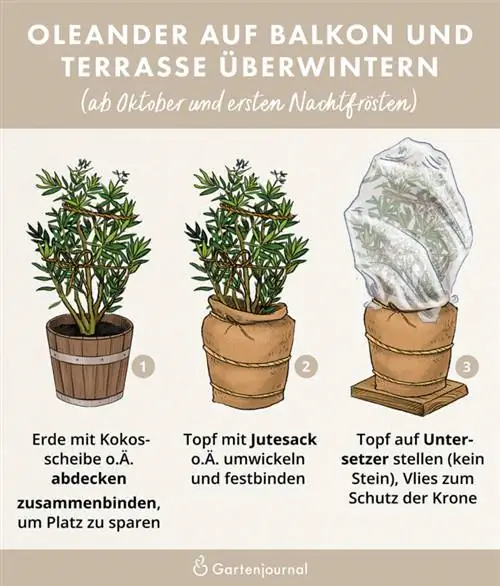
Instructions
- Tie the bush together with rope
- Place coconut mat on the ground
- Wrap the pot with a jute bag, felt mat or bubble wrap
- Put the fleece bag over the entire plant
- Place a wooden board or polystyrene plate under the pot.
However, the fleece bag only slightly protects the shrub from heavy snowfalls. If these are required, it is recommended to place the bucket as close as possible to the wall of the house. If necessary, a temporary protection made of wooden boards can be placed around the bucket.
On sunny and warm days (>4 degrees Celsius), the fleece should be aired during the day. Even if the commercially available plastic fleeces are permeable to air, the ventilation is not sufficient in the long term. Regular ventilation prevents the formation of mold or other diseases under the hood due to excessive humidity.
In the ground
Overwintering oleander outdoors is only possible in particularly mild winter locations. In Germany the number of these areas is limited to a few. These include
- River Valleys
- Lower Rhine
- Rhineland
- Wine growing areas
In all other areas, overwintering in the ground is strongly discouraged. However, you are free to try leaving your oleander in place. However, as with the container planting described above, the plant requires special protection.
Freely planted specimens should also be protected from snow loads by a sturdy cover. In the worst case scenario, these can crush the plant.
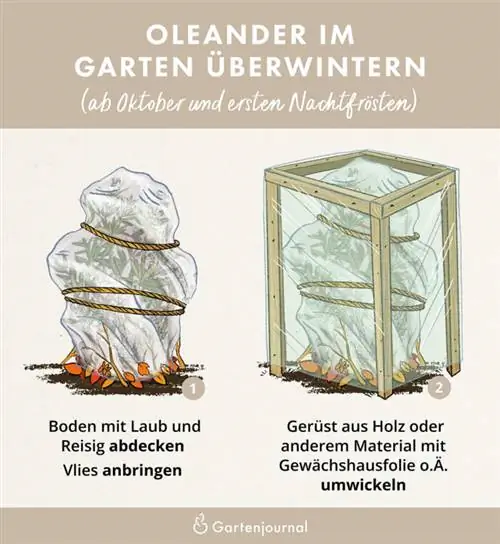
Instructions
- tie individual shoots of the bush together
- wrap with several layers of fleece
- Spread leaves all around
- Build wooden scaffolding
- Cover gaps with weatherproof tarpaulin
Alternatively, the area around the bush can also be covered with brushwood or fleece. When choosing the right material, air circulation plays a crucial role. This prevents the development of rot and the deposition of pathogens.
If your oleander is already planted near a house wall, this can serve as a back wall for the scaffolding. Regardless of the location chosen, constant expansion of the scaffolding is necessary due to constant growth. Consider this before planting your shrub in the ground.
Overwintering oleander in the house and greenhouse
Wintering indoors is one of the most common variants. The oleander is moved to a frost-free place during the frost period to protect it from damage.
Greenhouse and unheated winter garden
When placed in a greenhouse or an unheated winter garden, the plant and its pot are safely housed. Sufficient light reaches the plant through the glass cover. This means the oleander can continue to photosynthesize.
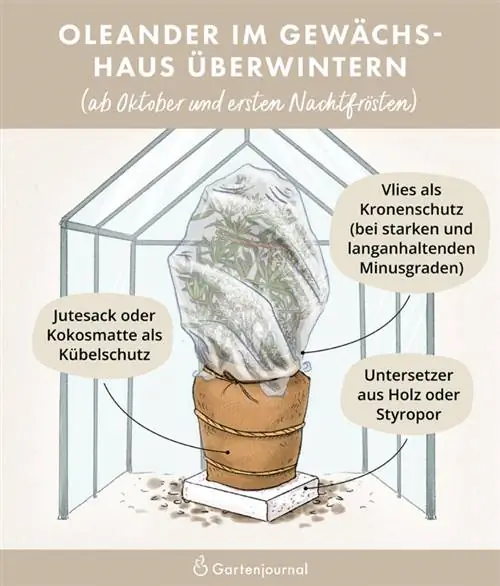
The pot and the roots in it should always be protected with a jute bag. For stone floors, you should also pay attention to a layer of wood or polystyrene that keeps the cold out from below.
At temperatures below -10 degrees Celsius, the plant should still be given additional protection. The cold can be kept out from outside with fleece, felt or bubble wrap. But make sure that the hood is ventilated regularly.
We also recommend using a frost monitor (€49.00 on Amazon), which regulates the temperature. The Firefly Terracotta Frost Guard from Bio Green is completely glazed and therefore very durable. By inserting a candle, a temperature of up to 70 degrees Celsius is achieved inside, which optimally warms the surrounding room. In this way, sub-zero temperatures in the interior can be avoided.
Hallway and garage
Wintering in the hallway or garage is generally possible. The hallway in particular should definitely be unheated. The ideal wintering temperature is between two and ten degrees Celsius. The lower the lighting intensity, the lower the maximum temperature can be. Nevertheless, exposure should also take place at these locations at least on an hourly basis. Direct sunlight should be avoided in any case.
Apartment
Wintering in the heated apartment isnot possible. Due to the high room temperature, the oleander cannot go into hibernation. In addition, a room temperature of over ten degrees Celsius increases the risk of scale insect infestation.
Care in winter
Even in the winter months, moderate care of the oleander is recommended to maintain its vitality.
Watering:Since the shrub is in a dormant phase in winter, watering can be reduced to amoderate level. Ideally, the plant should be checked and watered once a week on a frost-free day when the top layer of soil is dry. If the surrounding substrate is still moist, this rhythm can be extended to two weeks. Otherwise there is a risk of waterlogging in the root area, which can lead to significant damage. Therefore, check the substrate moisture beforehand with a finger test.
Fertilizing:Although the oleander is a heavy feeder, fertilizing isnot necessary until early spring. Adding fertilizer can even lead to a stress reaction in the plant. This is particularly evident in the wilting of the leaf edges.
Diseases and pests in winter quarters
Although oleander is generally considered a very robust plant, it is often attacked by pests. Various fungal and bacterial infections are also increasing. Already weakened and dormant plants are particularly easy targets for all kinds of diseases.
Frost Damage
Frost damage mainly occurs on plants that were brought into winter quarters too late. Visually, these shoots are dry and brown. These areas cannot be saved later, so they should be cut back to he althy wood. If your oleander is severely frozen above ground, there is also a risk that the roots will be frozen. In principle, the vigorously growing shrub can sprout completely again even after radical pruning. However, this requires a he althy root system. If this is too badly damaged by the frost, the only solution is to remove the plant.
Pest Infestation
Oleander is very susceptible to pests such as scale insects and spider mites all year round. Preventive measures are therefore essential.
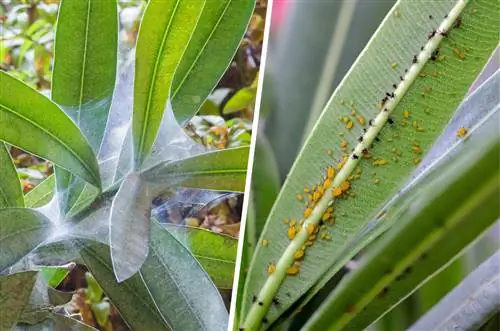
Spider mites (left) and scale insects (right) are among the most common pests in winter quarters.
Spider mites
An infestation with spider mites is often only discovered very late due to the insects' small size of just a few millimeters. In addition, both the pests and their eggs are located primarily on the underside of the leaves. However, the consequences on the leaves are visible a little earlier. The leaf veins are bright. In addition, a silvery, cobweb-like fuzz can usually be seen.
Before resorting to insecticide, more environmentally friendly alternatives should be used. It is usually enough to clean the entire oleander with a strong jet of water. The spider mites cannot adhere to damp surfaces and are washed away. Remaining eggs can be removed by wrapping the bush with plastic wrap. The increased humidity leads to death after about two to three days.
Leaves that are already discolored do not fully recover, even after successful control. The only thing that helps here is a pruning.
Scale insects
Due to their size of only three millimeters, scale insects are difficult to recognize despite their black coloring. What is more noticeable is the sticky juice that the insects secrete. Depending on the severity of the infestation, this can be seen on leaves, flowers and shoots. The sweet taste attracts other insects such as ants, which use the juice. The juice is also an unintentionally good breeding ground for the settlement of fungal spores. The dangerous sooty mold fungus in particular often occurs in conjunction with scale insect infestation.
If an infestation is detected in good time, the use of insecticides can be dispensed with. The first step should be to spray the entire plant with soapy water. The greasy surface means that the insects can no longer hold on and can be easily removed. This can be done with a jet of water, but also by hand with a cloth.
Diseases in winter quarters
The oleander is at risk from pathogens and spores not only in the open field. In winter, plants are usually even more vulnerable due to the slowed metabolism. Regular checks are therefore essential, even in winter quarters.
Dry rot
Dry rot is a widespread fungal disease that does not only occur in winter quarters. Ascochyta is mainly spread via irrigation water. The spores attack soft plant parts such as young shoots, leaves and flowers from the outside. They then use these to penetrate the oleander. Poorly healed wounds are also a preferred entry point. The affected areas appear dried out after a while, even though there is sufficient watering.
As it is a fungal disease, dry rot can be controlled with a suitable fungicide. This can also be applied to the plant as a preventative measure to protect it. In addition, as a preventive measure, sufficient planting distance should be maintained. The fungal spores feel particularly comfortable in damp and warm areas that are also poorly ventilated. If the infestation has progressed too far, large areas of the affected areas must be cut out. The subsequent disposal should be carried out with residual waste to avoid reinfection.
Gray horse
Gray mold is also a fungal disease and can also occur outside of the winter quarters. However, the spores only settle on the dried flower buds. As a result of the disease, these have a grayish-white coating.
Treatment with a fungicide is usually not necessary as the damaging effect of the fungus is significantly less than that of dry rot. However, affected flowers should be removed. In order to prevent an infestation, it is recommended to regularly thin out the dried parts of the plant. This significantly reduces the attack surface for the fungal spores.
Oleander crab
The bacteria that cause oleander canker are found in the sap of every type. However, it does not break out in every specimen. However, the causes for this are still unknown to this day. The outbreak can be visually recognized by broken plant parts. In addition to buds and leaves, shoots are also affected. Misshapen, cauliflower-like growths then grow from the open areas.
There is currently no effective treatment. To avoid excessive weakening of the plant, the affected areas should be cut out generously. Due to the high growth rate after pruning, the resulting holes should be able to be closed more quickly. In order to avoid transferring the bacteria to other plants, it is recommended to thoroughly disinfect the tools used. In addition, the affected plant parts should be disposed of with the residual waste. An entry into the compost can lead to renewed transmission and infection.
Wintering out oleander
Especially after a dark winter, the oleander must slowly be acclimated to the outdoors again. Ideally, overwintering takes place according to the following scheme:
- 1. - 2nd week of wintering: exclusively shady location
- 3. Until the 4th week of wintering: place in the sun for a few hours, but definitely avoid the midday sun.
- from the 5th week of hibernation: placement in the desired location in full sun
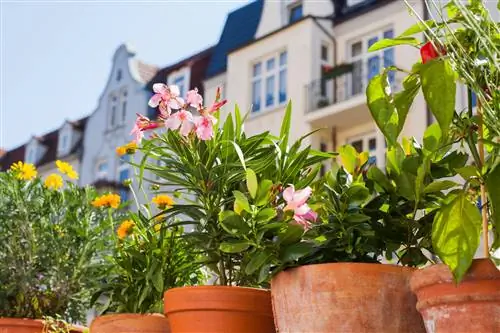
Oleander should be gradually introduced to a full sun location. Otherwise there is a risk of irreparable damage to the leaves due to sunburn.
In order to keep the stress on the shrub as low as possible, it should be watered well during wintering. This reduces the risk of irreparable sunburn on the leaves. Also pay attention to nighttime temperatures during wintering. Night frosts are not uncommon until the Ice Saints at the end of May.
FAQ
How do you overwinter oleander?
Oleander is ideally overwintered in a frost-free but bright place. The lower the exposure, the lower the outside temperature can be. Under no circumstances should this fall below two degrees Celsius. However, at temperatures above ten degrees Celsius, the bush cannot go into hibernation.
When and how long do oleanders overwinter?
When the night frosts begin, the oleander should be brought into its winter quarters, but at the latest when permanent frost threatens during the day. Winterization is then possible gradually in May with temperatures above zero during the day. However, the oleander needs to get used to the higher temperatures and the larger amount of light over several weeks.
Are there hardy oleanders?
Basically all species are hardy down to temperatures of -5 degrees Celsius. If this limit is permanently exceeded, frost damage can occur. However, a few varieties are also frost hardy down to -15 degrees Celsius. These include the genera Hardy Red, Italia, Jannoch, Margarita, Nerium atlas, Nerium villa romaine and Provence.
Can oleander be overwintered in the bed?
In principle, oleander can be overwintered in the bed. However, due to the severe frosts in Germany, this is only possible in a few regions. River valleys, the Lower Rhine, the Rhineland and wine-growing areas are particularly mild in winter. In all other locations, overwintering in the bed is strongly discouraged.
How do you overwinter oleander in the bed?
Even in the milder regions of Germany, the oleander needs suitable winter protection. The surface of the earth should be protected with leaves. It is also recommended to wrap the bush with a fleece. To protect against snowfall, a scaffold covered with tarpaulin should be erected around the plant.

